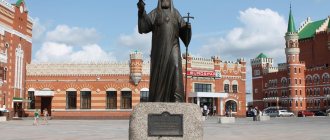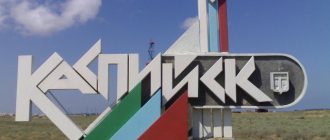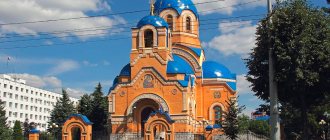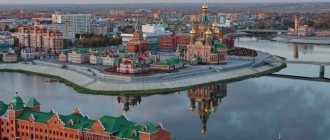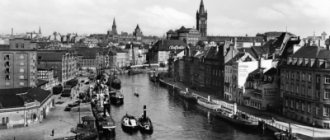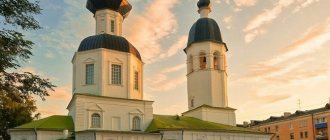- Reports and messages
- Miscellaneous
- Yoshkar-Ola city
The city of Yoshkar-Ola is the administrative center of the urban district and the capital of the Mari-El Republic, with a population of 271,868 thousand people.
The founding date of the city is considered to be 1584; construction took place under Tsar Fyodor Ioannovich. The founding of the city is associated with tragic events; it was at this time that uprisings took place in the annexed Kazan Khanate. After which, Ivan the Terrible issued a decree on the construction of fortress cities to strengthen the troops. At the beginning of the twentieth century, Yoshkar-Ola was a small city with a population of about 2,000 thousand people. A great impetus to the development of the city occurred during the Great Patriotic War, when many factories were evacuated to Yoshkar-Ola. As a result, massive development of the city took place.
After the collapse of the Soviet Union, many projects were adopted and developed to develop the socio-economic environment of the city. Some programs are still being implemented.
As for the economic situation, Yoshkar-Ola is a rapidly developing city with a flexible economy. About 70% of GDP comes from industry, in particular manufacturing and raw materials, due to its geographical location.
Also, culture and art are developing in the city; there are a large number of cultural objects on the territory. These include theaters, museums, cinemas, and libraries. For example, the Museum of the History of the City, founded in 1996, the National Museum of the Republic of Mari-El. Among the theaters, one can note the Academic Russian Drama Theater named after G.V. Konstantinov, which is one of the first built in the city, back in 1937.
Education in the city is represented by higher educational institutions, at the moment there are only three of them: Volga State Technological University, Mari State University, and the youngest of them, the Interregional Open Social Institute, which was founded in 2003. Average professional circumcision is represented by fourteen institutions.
Among the attractions and other significant objects, one can highlight various residential buildings, for example, the house of the merchant Pchelin, 1756, and the timber merchant Bulygin, 1835. The new Patriarchal Square, built in 2010, will surprise and delight. There are many parks, squares and fountains in the city, the main one among them is the Central Park of Culture and Recreation.
In general, we have touched upon the main aspects of the urban environment, from which we can conclude that Yoshkar-Ola is a fairly good city for a calm and happy life.
Option No. 2
1584 is considered the year of the founding of the city of Yoshkar-Ola. Now it has become the administrative center of the urban district, and the capital of the Republic of Mari-El. It is home to approximately 270 thousand people. Yoshkar-Ola or Red City. The city had different names in different years. Yoshkar-Ola is included in the list of Russian cities with a rich historical past. On June 22, 2011, the city received a coat of arms, flag and anthem.
At the beginning of the 20th century it was a small settlement. The impetus for development was the Great Patriotic War, because factories were evacuated here from the front. Massive construction of the city began immediately. At the beginning of the 20th century, the city was a small settlement.
The Malaya Kokshaga River flows through the city, it divides the city into two parts, the banks are connected by 8 bridges.
Attractions include various residential buildings, the new Patriarchal Square, numerous fountains and parks, the main one being the Central Park of Culture and Leisure. There are also several museums and theaters throughout the year.
It will be useful for children to visit the cheese museum, where, in addition to the excursion, they can try cheese and try to make it themselves.
There are many sculptures throughout the city. There is a monument dedicated to the letter Y, a hammer, and a sundial. The city even installed smaller copies of the Spasskaya Tower and the Tsar Cannon.
A bench of love and fidelity was installed in the city for lovers and newlyweds. To attract success in business, local residents rub the belly of a bronze elephant on Sovetskaya Street. The fabulous Lukomorye appeared in the city, in which there is a cat with a mermaid, and Baba Yaga with Koshchei. The composition “Happy Family” was installed near the maternity hospital.
A big and fat Yoshkin cat sits near the university. He has become a talisman for students; before exams they stroke his nose and pass easily. But this is not the only cat in the city, there is another one with a friend.
And the beautiful Bruges embankment transports city guests and local residents who came out to get some fresh air to Amsterdam. The houses along it look like toys, everything is clean and beautiful.
Part 2. Architectural.
In addition to the “Embankment of Bruges”, Yoshkar-Ola still has something to boast about. Take, for example, the cultural and historical complex “Tsarevokokshay Kremlin”, built in 2009 according to all the canons of a fortification structure of the 14th-15th centuries, the only thing missing is embankments and a deep ditch:
(The photo is not mine, it was found on the Internet, I just didn’t have a good quality photo in my reserves)
On the territory of the Kremlin (by the way, the youngest in Russia) there is an exhibition of artillery pieces, as well as stands with the history of the Mari land and a small chapel.
In addition to the Kremlin, there are unique fortress walls on the right bank of the Kokshaga River, behind them are “hidden”: the recently built Cathedral of the Resurrection of Christ, several government buildings and residential buildings, all of this together creates a beautiful picture, not inferior in beauty to the Bruges embankment located opposite:
The same thing, but a little closer and from a different angle:
On Patriarchal Square, which is located on the left bank of the river, in addition to the monuments to Alexy II and Peter and Fevronia, which I already talked about above, you can see two unusual buildings: this is the “12 Apostles” complex, similar to a fairy-tale palace, which includes a restaurant, supermarket and television and radio company:
The photo is not mine either. The same problem: there is no high-quality photograph of this building, taken from this site
and the Republican Puppet Theater, stylized as a medieval castle, not yet completed:
The “12 Apostles” complex, in addition to its appearance, is also interesting because of the performance that takes place every three hours, repeating the well-known gospel story - the Entry of the Lord into Jerusalem. To the accompaniment of music, 12 apostles led by Jesus appear from the tower, walk along the balcony and hide in another tower. A fascinating and exciting spectacle.
A similar mechanical system operates in another building - the Italian-style National Art Gallery, which is located on the square. Obolensky-Nogotkov, next to the monument to the governor:
Every hour, accompanied by church hymns, a plot is played out around the central clock telling about the salvation of the “Three-Handed” Icon of the Mother of God during the Turkish invasion of Serbia. An image of the Mother of God appears in the upper left corner of the clock, then a donkey with her image appears from the lower left gate, symbolizing the miraculous salvation of the icon and the coming of the Mother of God. The donkey enters the right gate, it closes, after which the blessing image of the Queen of Heaven appears above it again.
Another attraction of Yoshkar-Ola is the Annunciation Tower, which is a smaller copy of one of the towers of the country’s main Kremlin. The chimes, like the original, chime every hour.
In the next photo, in front of the tower you can see one of the largest fountains in the city - the Archangel Gabriel fountain, trimmed with green malachite stone:
Next to the Annunciation Tower is the Arkhangelskaya Sloboda - a small pedestrian area built up with Italian-style mansions, in which there are service offices for a number of banks and government services.
At Arkhangelskaya Sloboda, I will finish the story about the main attractions of Yoshkar-Ola, however, once in this city, you can discover many interesting and beautiful places that are not described in this review. Be sure to visit the newly built Cathedral of the Annunciation of the Blessed Virgin Mary, stroll along Assumption Street and the flower-filled Chavaina Boulevard, sit in the quiet and cozy park of the government building.
Popular message topics
- Traffic rules
Traffic rules existed during the reign of Caesar. Given the huge number of horse-drawn vehicles in Rome, one-way traffic was introduced on some streets. The people who came to the city in their carts - Byzantium
The Roman Empire was a huge powerful state, but when Emperor Theodosius died, its territories were divided into eastern and western parts. The Roman Western Empire did not last long. Now all that remains on the map is - Algae in nature
The main habitat for algae is water bodies. Algae are unicellular, and some forms are multicellular organisms. Many of them are largely similar to each other according to certain criteria. Based on the fact that these plants are very
Traditions, culture and holidays
The indigenous population of the republic are the Mari. These are the Finno-Ugric people who inhabited these places in ancient times.
The Mari carefully preserve the traditions of their ancestors, their customs and cultural heritage. They speak the Mari language and wear colorful costumes.
They have their own holidays, although the Mari also celebrate the usual solemn dates for our country.
Kind and friendly people live in Yoshkar-Ola, very cheerful and loving to guests. It is customary for us to have fun celebrating various holidays.
My favorite holiday is New Year. But I also love to see how City Day is celebrated.
It is celebrated on the first Saturday after August 6th.
Famous fellow countrymen
Our republic has always had a lot of talented, passionate people who have made a huge contribution to the development of the city and region.
Among them are the linguist Vasily Bogoroditsky, actress Ekaterina Skulkina, showman Roman Popov, musician Mikhail Krasnov, gymnast Zinaida Voronina.
Attractions
My city is famous for its amazingly beautiful architecture and unusual monuments.
For example, the embankment on the Kokshaga River resembles Belgium or Holland with its neat, colorful houses.
The Annunciation Tower on Republic Square resembles in its shape the Spasskaya Tower in Moscow.
The fairytale castle of the Emerald City resembles a Puppet Theater.
There are many other theaters and cultural institutions in the city. There are national and dramatic theatres, opera and ballet, about twenty museums and art exhibitions.
The Tsarevokokshay Kremlin, a restored medieval fortress, is a cultural heritage site.
My favorite places
My favorite place to walk in the city is Arkhangelskaya Sloboda. This is a very beautiful complex of several buildings designed in European style. Here you can take a walk and admire the unusual views.
Another beautiful place in the city is the pedestrian Chavaina Boulevard. This is a favorite place for walks for tourists and city residents themselves. There are several fountains and beautiful flower beds. And the boulevard ends in parks, where there is a lot of greenery and shady alleys.
Since this year, my new school has become another favorite place of mine. This is a very beautiful and comfortable building, where I will have to study various sciences.
Conclusion:
Every person has his Great Motherland, the country in which he was born. But there is also a place that he calls his Little Motherland. This is his hometown, the street, the house where he spent his childhood. And any person will always love his Small Motherland no less than his Big Motherland.
Poem about Yoshkar-Ola:
Yoshkar-Ola, on the Small River, It nourishes it with moisture. It’s a gorgeous place, far away from everyone, where the Kokshaga flows into the Volga. And if you look down from space, Razdolie, in the Russian outback, the Fatherland! Be proud of Yoshkar-Oloya, Great and pure love. The accent of the people is cheerful, dear, It fills my heart like a song. Oh, how much culture we have, Russia, which we are proud of. And if an evil enemy approaches the borders, Yoshkar-Ola will respond, Hey enemy, your chance is absolutely zero, We will have to deprive him too.
Sergey Akulov
Best hotels in Yoshkar-Ola
Related materials:
- 28 best sights of Uglich, recommended for…
- 28 best attractions of Rostov Veliky that…
- 31 attractions of Ryazan that are worth seeing
- 38 sights of Pskov recommended for…
- 28 Belgrade attractions worth visiting
- 36 attractions of Astrakhan recommended for…
- 29 best attractions in Orel, recommended for…
- 42 best must-see attractions in Rome
- 36 Izmir attractions recommended for…
Did you like the article? Share with friends:
What to visit in Yoshkar-Ola for free:
Assumption Street and the Church of the Assumption of the Blessed Virgin Mary
Assumption Street and the Church of the Assumption of the Blessed Virgin Mary
The Church of the Assumption of the Blessed Virgin Mary is located next to the Government House; its construction was timed to coincide with the 60th anniversary of the victory in World War II. The temple was consecrated immediately - on August 28, 2006.
Nearby is the chapel named after St. Nicholas, and the Church of the Assumption itself is decorated with hand-made wall mosaics, an altar and painted icons.
Address: Uspenskaya street, 40, Yoshkar-Ola
Opening hours: daily, Monday – closed; morning service – 8:00, evening – 17:00
Entry: free
Official website: https://uspenie-ola.cerkov.ru/
"Yoshkin cat"
"Yoshkin cat"
Located near the main entrance to the University of Mari. The sculpture was created in 2011 in Kazan, and then transported to Yoshkar-Ola. Interesting fact: the prototype was a cat who lived in the creators’ studio.
During the existence of the sculpture, many legends appeared around it. They say that if you rub a cat's paw, it will bring good luck. In total, there are already as many as 5 sculptures dedicated to cats in the city.
Address: Leninsky Prospekt, Yoshkar-Ola
Opening hours: 24 hours a day
Entry: free
Square of the Republic and the Blessed Virgin Mary
Square of the Republic and the Blessed Virgin Mary
The Square of the Republic and the Blessed Virgin Mary was built in 2007 and received this name for a reason. As planned, this name should symbolize the connection between the Republic of Mari El and the Virgin Mary.
A fountain was installed on the square, which is decorated with sculptures. The sculptures play out the plot of the Feast of the Annunciation, in honor of which the Cathedral of the Blessed Virgin Mary was built.
Address: Republic Square and the Blessed Virgin Mary, Yoshkar-Ola
Opening hours: 24 hours a day
Entry: free
Medici Park
Medici Park
The main element of the park is the sculpture of Lorenzo de' Medici, the height of which reaches 3.5 meters, and it is cast entirely from bronze. It was created in 2012 with money from patrons.
The compact park includes alleys planted with maple trees. The park ensemble was built in the Italian style and is a symbol of the prosperity of the Republic.
Address: Voskresenskaya embankment, Yoshkar-Ola
Opening hours: 24 hours a day
Entry: free
Blagoveshchensky cathedral
Blagoveshchensky cathedral
The temple is the main element of the architectural complex erected on the river embankment, as well as the cathedral of the Mari diocese.
The parish of the Annunciation Cathedral was originally created to attract a new generation and introduce them to the Orthodox faith. It’s worth a visit if only for its impressive size and aesthetic considerations.
Address: Voskresenskaya embankment, 32, Yoshkar-Ola
Opening hours: daily, morning service – 8:00, evening – 17:00
Entry: free
Official website: https://mari.eparhia.ru/churches/eparhii_yoshkar-olinskoi/capital/?ID=5222
Gogol Square
Gogol Square
This is one of the best squares in the city. Oddly enough, it is decorated with a monument to the writer Nikolai Vasilyevich Gogol.
If you walk a little, you will see Gogolevsky Boulevard, which was built quite recently, at the end of 2014, and behind it is the Gogolevsky Bridge, running across the Malaya Kokshaga River.
Address: Gogol street, Yoshkar-Ola
Opening hours: 24 hours a day
Entry: free
Resurrection Cathedral
Resurrection Cathedral
The cathedral was built in 1759; funds from parishioners and the merchant Bulygin were used for the construction. It also hosts water blessing prayers for expectant mothers twice a month.
On the territory of the Resurrection Cathedral there are several chapels, and inside everything is decorated with icons and crosses, in the center there is an altar.
Address: Voznesenskaya street, 45, Yoshkar-Ola
Opening hours: Wednesday - Sunday, morning service - 8:00, Wednesday at 7:30, evening - 16:30
Entry: free
Official website: https://mari.eparhia.ru/churches/eparhii_yoshkar-olinskoi/capital/?ID=5224
